Investigation on Residual Stress Loss during Laser Peen Texturing of 316L Stainless Steel
Abstract
:1. Introduction
2. Methods and Materials
3. Simulation Procedure
3.1. Specimen Modeling
3.2. Material Definition
3.3. Derivation of Laser Shock Pressure
3.4. Calculation
4. Simulation Results and Discussion
4.1. Comparison of Dimple Profile and Depth between Experimental and Numerical Results
4.2. Mechanism for the Generation of Residual Stress Loss
4.3. Evaluation Method of Residual Stress Field
4.4. Effect of Laser Power Density
4.5. Effect of Laser Spot Radius
5. Conclusions
- (1)
- A simulation model was proposed and the deformation, as well as the stress distribution of the specimen, was investigated. The profile of micro dimple calculated by the simulation agrees well with the measured ones in experiment.
- (2)
- An evaluation method of residual stress field was established. The residual compressive stress, the magnitude of residual stress loss, and the affecting zone size of residual stress loss can be characterized quantitatively by this method.
- (3)
- When the laser power density increases from 2.21 GW/cm2 to 13.80 GW/cm2, the magnitude of the residual stress loss increases from 46.2 MPa to 876.1 MPa along the radial direction, and from 132.1 MPa to 1297.5 MPa along the depth direction, respectively. Meanwhile, the affecting zone size of the residual stress loss increases from 59.2 μm to 425.2 μm along the radial direction and from 19.7 μm to 274.4 μm along the depth direction, respectively. When the laser power density exceeds a certain threshold, the residual stress on the surface changes from compressive stress to tensile stress.
- (4)
- Laser spot radius has a significant effect on residual stress loss. Large laser spot radius leads to more obvious residual stress loss. In this study, when the laser spot radius increases from 100 μm to 400 μm, the thickness and the width of the residual compressive stress layer increases from 175 μm to 565 μm and from 70 μm to 315 μm, respectively. However, the maximum residual compressive stress decreases from −495 MPa to −125 MPa along radial direction and decreases from −495 MPa to −350 MPa along depth direction, respectively.
Author Contributions
Funding
Conflicts of Interest
References
- Etsion, I. State of the art in laser surface texturing. J. Tribol-T. ASME 2005, 125, 248–300. [Google Scholar] [CrossRef]
- Wei, D.; Li, B.; Zhang, Z.; Han, F.; Zhang, X.; Zhang, M.; Li, L.; Wang, Q. Influence of surface texture characteristics on the noise in grooving concrete pavement. Appli. Sci. 2018, 8, 2141. [Google Scholar] [CrossRef]
- Yang, L.; Ding, Y.; Cheng, B.; He, J.; Wang, G.; Wang, Y. Investigations on femtosecond laser modified micro-textured surface with anti-friction property on bearing steel GCr15. Appl. Surf. Sci. 2018, 434, 831–842. [Google Scholar] [CrossRef]
- Zhou, J.; Shen, H.; Pan, Y.; Ding, X. Experimental study on laser microstructures using long pulse. Opt. Lasers Eng. 2016, 78, 113–120. [Google Scholar] [CrossRef]
- Ryk, G.; Kligerman, Y.; Etsion, I. Experimental investigation of laser surface texturing for reciprocating automotive components. Tribol. Trans. 2002, 45, 444–449. [Google Scholar] [CrossRef]
- Wang, J.; Zhang, J.; Lin, J.; Ma, L. Study on lubrication performance of journal bearing with multiple texture distributions. Appl. Sci. 2018, 8, 244. [Google Scholar] [CrossRef]
- Ito, H.; Kaneda, K.; Yuhta, T.; Nishimura, I.; Yasuda, K.; Matsuno, T. Reduction of polyethylene wear by concave dimples on the frictional surface in artificial hip joints. J. Arthroplasty 2000, 15, 332–338. [Google Scholar] [CrossRef]
- Zhang, Y.D.; Lin, J.Q.; Fu, Q.L.; Hu, H.Y. Measuring and controlling of arbor displacement in low frequency vibration machining surface for micro pits. J. ZheJiang Univ. 2008, 42, 1410–1414. [Google Scholar]
- Roy, T.; Choudhury, D.; Ghosh, S.; Mamat, A.B.; Pingguan-Murphy, B. Improved friction and wear performance of micro dimpled ceramic-on-ceramic interface for hip joint arthroplasty. Ceram. Int. 2015, 41, 681–690. [Google Scholar] [CrossRef]
- Shinkarenko, A.; Kligerman, Y.; Etsion, I. The effect of elastomer surface texturing in soft elasto-hydrodynamic lubrication. Tribol. Lett. 2009, 36, 95–103. [Google Scholar] [CrossRef]
- Jiao, L.; Chua, Z.Y.; Moon, S.K.; Song, J.; Bi, G.; Zheng, H.; Lee, B.; Koo, J. Laser-induced graphene on additive manufacturing parts. Nanomaterials 2019, 9, 90. [Google Scholar] [CrossRef] [PubMed]
- Müller, F.A.; Kunz, C.; Gräf, S. Bio-inspired functional surfaces based on laser-induced periodic surface structures. Materials 2016, 9, 476. [Google Scholar] [CrossRef] [PubMed]
- Tang, W.; Zhou, Y.; Zhu, H.; Yang, H. The effect of surface texturing on reducing the friction and wear of steel under lubricated sliding contact. Appl. Surf. Sci. 2013, 273, 199–204. [Google Scholar] [CrossRef]
- Wang, X.L.; Adachi, K.; Otsuka, K.; Kato, K. Optimization of the surface texture for silicon carbide sliding in water. Appl. Surf. Sci. 2006, 253, 1282–1286. [Google Scholar] [CrossRef]
- Liu, H.; Sun, X.; Shen, Z.; Li, L.; Sha, C.; Ma, Y.; Gau, J.; Wang, X. Experimental and numerical simulation investigation on laser flexible shock micro-bulging. Metals 2017, 7, 93. [Google Scholar] [CrossRef]
- Dai, F.; Zhang, Z.; Ren, X.; Lu, J.; Huang, S. Effects of laser shock peening with contacting foil on micro laser texturing surface of Ti6Al4V. Opt. Lasers Eng. 2018, 1, 99–105. [Google Scholar] [CrossRef]
- Zhang, W.; Lu, J.; Luo, K. Residual stress distribution and microstructure at a laser spot of AISI 304 stainless steel subjected to different laser shock peening impacts. Metals 2015, 6, 6–15. [Google Scholar] [CrossRef]
- Peyre, P.; Fabbro, R.; Merrien, P.; Lieurade, H.P. Laser shock processing of aluminum alloys. Application to high cycle fatigue behaviour. Mat. Sci. Eng. A 1996, 210, 102–113. [Google Scholar] [CrossRef]
- Zhang, W.; Yao, Y.L. Micro scale laser shock processing of metallic components. J. Manuf. Sci. Eng. 2002, 124, 369–378. [Google Scholar] [CrossRef]
- Wu, B.; Tao, S.; Lei, S. Numerical modeling of laser shock peening with femtosecond laser pulses and comparisons to experiments. Appl. Surf. Sci. 2010, 256, 4376–4382. [Google Scholar] [CrossRef]
- Vasu, A.; Grandhi, R.V. Effects of curved geometry on residual stress in laser peening. Surf. Coat. Tech. 2013, 218, 71–79. [Google Scholar] [CrossRef]
- Vasu, A.; Hu, Y.X.; Grandhi, R.V. Differences in plasticity due to curvature in laser peened components. Surf. Coat. Tech. 2013, 235, 648–656. [Google Scholar] [CrossRef]
- Ding, K. Three-dimensional dynamic finite element analysis of multiple laser shock peening processes. Surf. Eng. 2003, 19, 351–358. [Google Scholar] [CrossRef]
- Brockman, R.A.; Braisted, W.R.; Olson, S.E.; Tenaglia, R.D.; Clauer, A.H.; Langer, K.; Shepard, M.J. Prediction and characterization of residual stresses from laser shock peening. Int. J. Fatigue 2012, 36, 96–108. [Google Scholar] [CrossRef]
- Luo, K.Y.; Lin, T.; Dai, F.Z.; Luo, X.M.; Lu, J.Z. Effects of overlapping rate on the uniformities of surface profile of LY2 Al alloy during massive laser shock peening impacts. Surf. Coat. Tech. 2015, 266, 49–56. [Google Scholar] [CrossRef]
- Zhang, X.; Li, H.; Duan, S.; Yu, X.; Feng, Y.; Wang, B.; Huang, Z. Modeling of residual stress field induced in Ti-6Al-4V alloy plate by two sided laser shock processing. Surf. Coat. Tech. 2015, 280, 163–173. [Google Scholar] [CrossRef]
- Hu, Y.X.; Gong, C.; Yao, Z.Q.; Hu, J. Investigation on the non-homogeneity of residual stress field induced by laser. Surf. Coat. Tech. 2009, 203, 3503–3508. [Google Scholar] [CrossRef]
- Tan, Y.; Wu, G.; Yang, J.M.; Pan, T. Laser shock peening on fatigue crack growth behaviour of aluminium alloy. Fatigue Fract. Eng. Mater. Struct. 2004, 27, 649–656. [Google Scholar] [CrossRef]
- ABAQUS, Inc. Analysis. In Abaqus Analysis User’s Manual; ABAQUS, Inc.: Palo Alto, CA, USA, 2003; Volume II. [Google Scholar]
- Johnson, G.R.; Cook, W.H. A constitutive model and data for metals subjected to large strains, high strain rates and high temperatures. In Proceedings of the 7th International Symposium on Ballistics, Hague, The Netherlands, 19–21 April 1983; pp. 541–547. [Google Scholar]
- Chandrasekaran, H.; M’saoubi, R.; Chazal, H. Modelling of material flow stress in chip formation process from orthogonal milling and split Hopkinson bar tests. Mach. Sci. Tech. 2005, 9, 131–144. [Google Scholar] [CrossRef]
- Fabbro, R.; Fournier, J.; Ballard, P.; Devaux, D.; Virmont, J. Physical study of laser-produced plasma in confined geometry. J. Appl. Phys. 1990, 68, 775–784. [Google Scholar] [CrossRef]
- Zhang, W.; Yao, Y.L.; Noyan, I.C. Microscale laser shock peening of thin films, part 1: Experiment, modeling and simulation. J. Manuf. Sci. Eng. ASME 2004, 126, 10–16. [Google Scholar] [CrossRef]
- Ballard, P. Residual stresses induced by rapid impact-applications of laser shocking. J. Phys. 1991, 1, 487–494. [Google Scholar]
- Peyre, P.; Berthe, L.; Fabbro, R. Laser shock processing of materials: Basics mechanisms and applications. In Proceedings of the 65th Meeting of Japan Laser Processing Society, Tokyo, Japan, 2–5 December 2005; Volume 12, pp. 95–109. [Google Scholar]

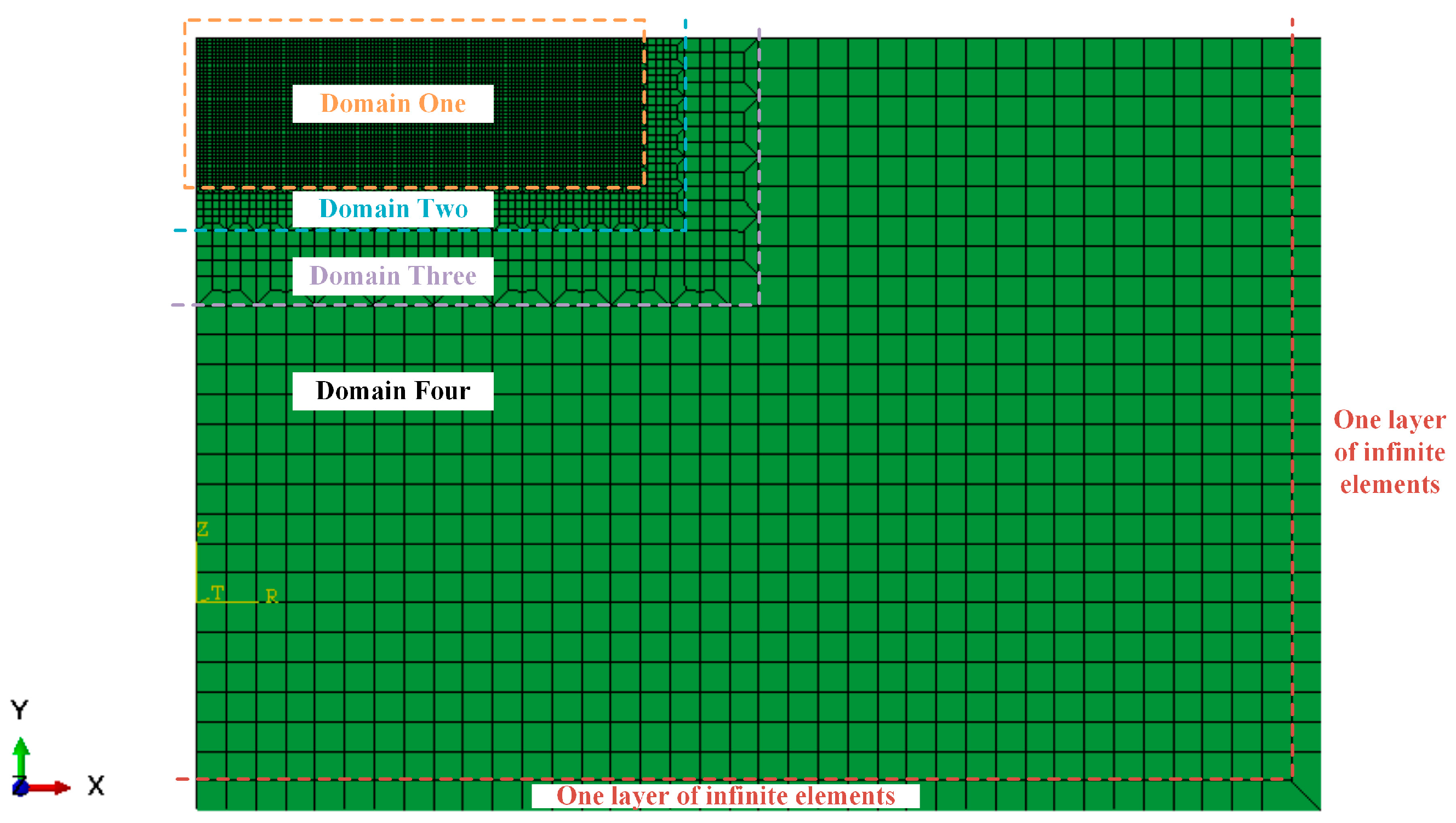

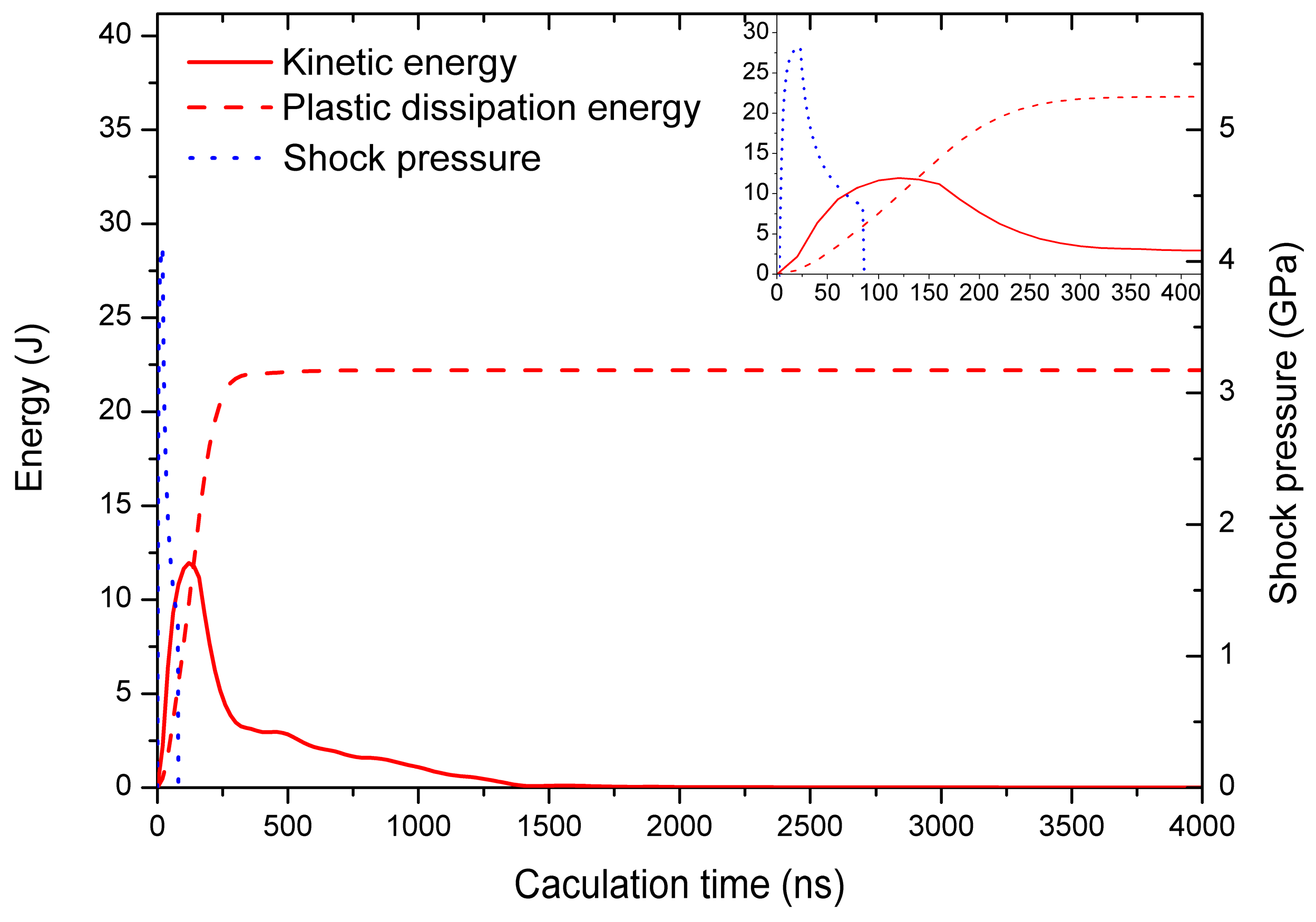

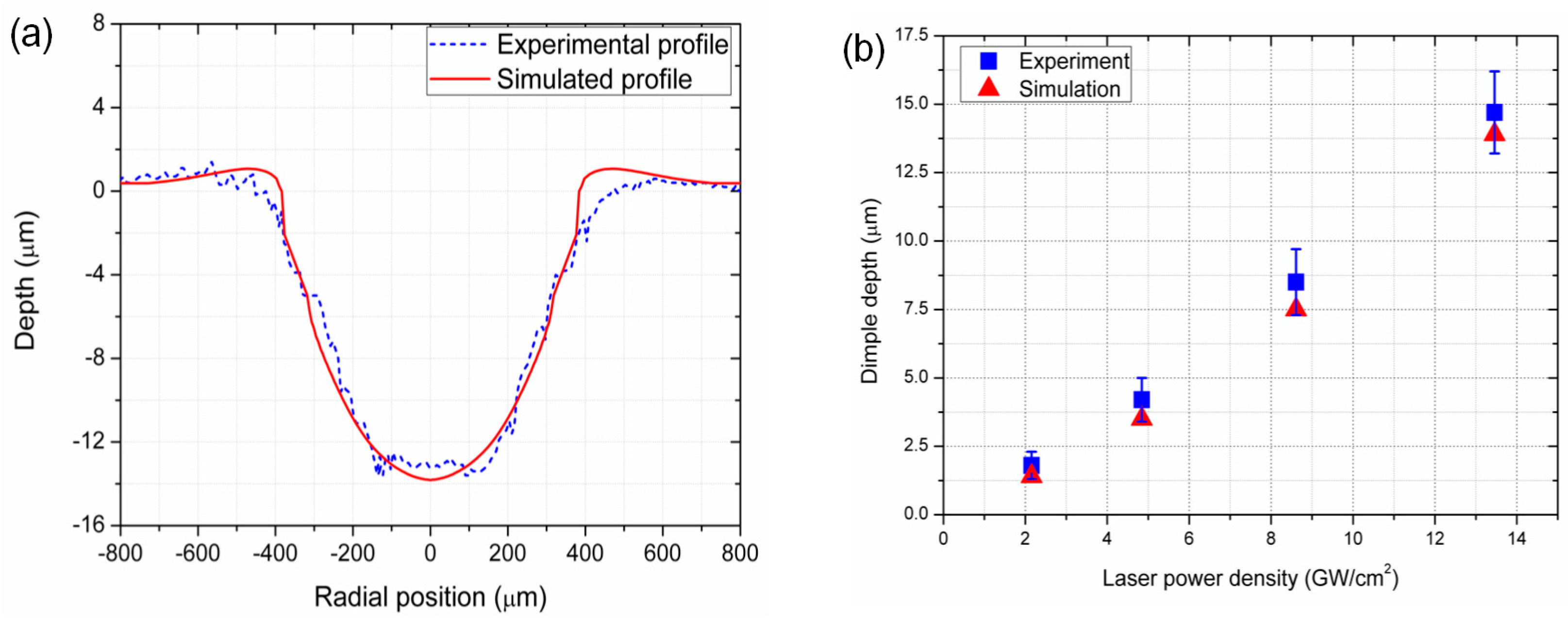


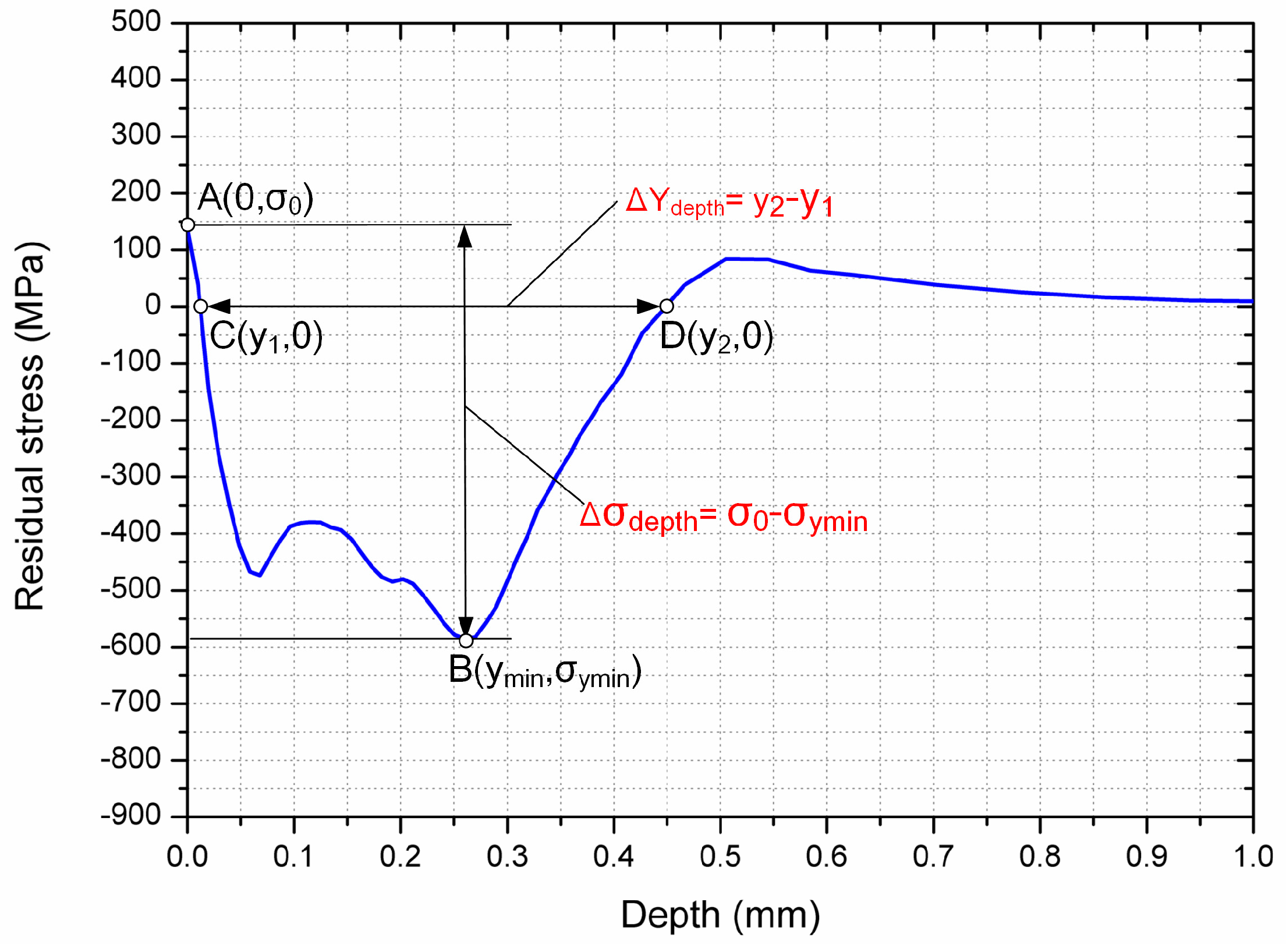
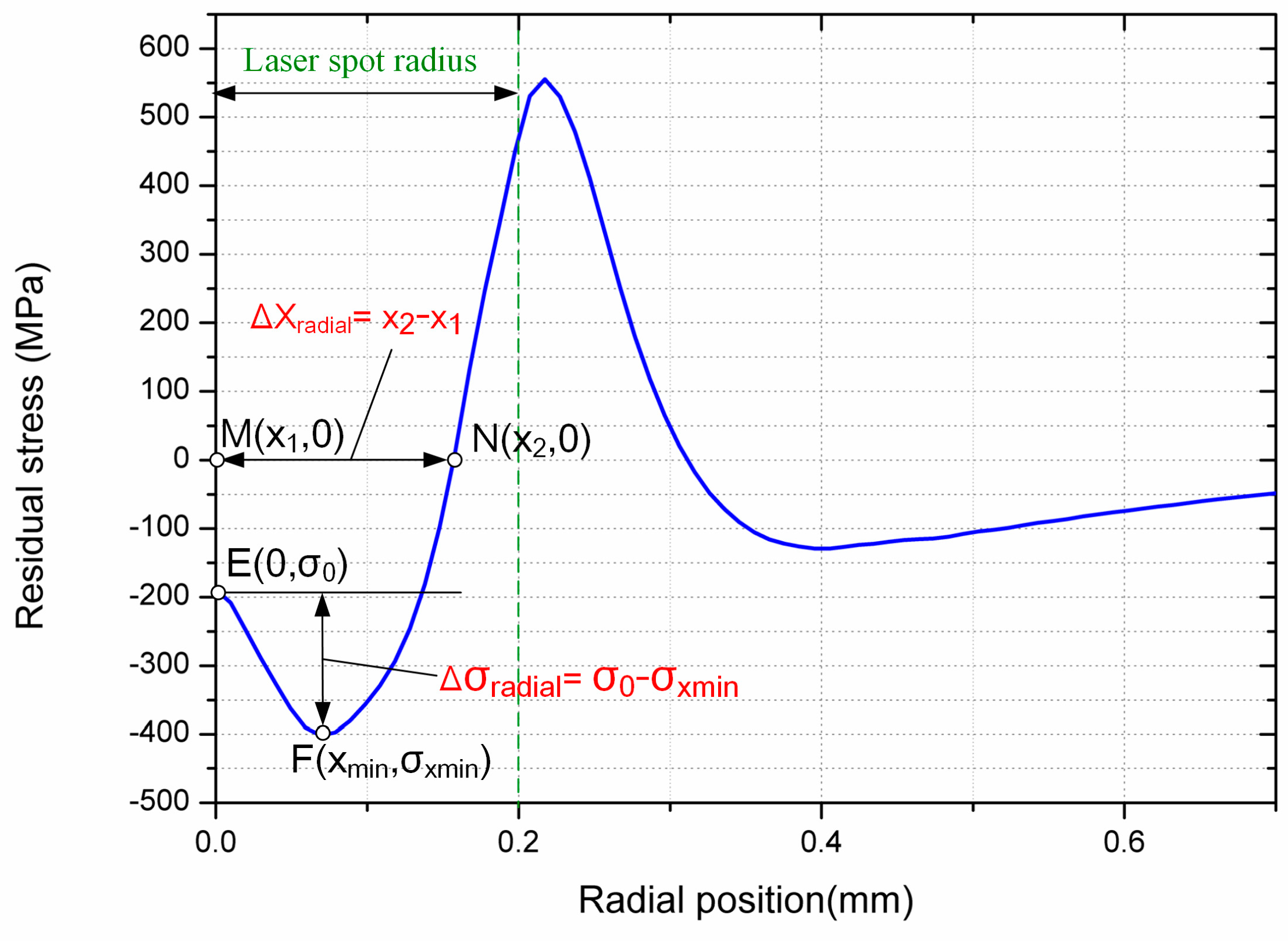


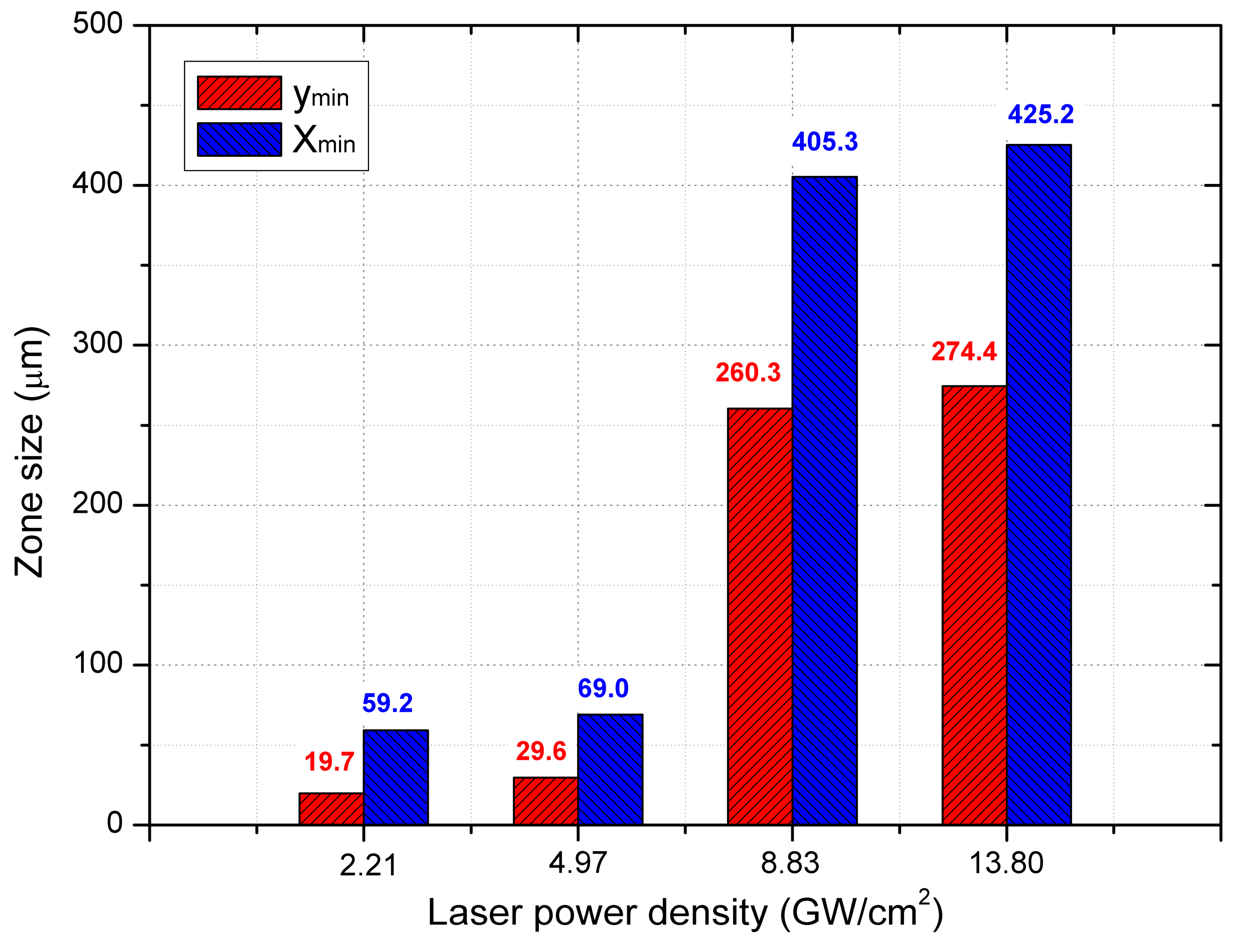
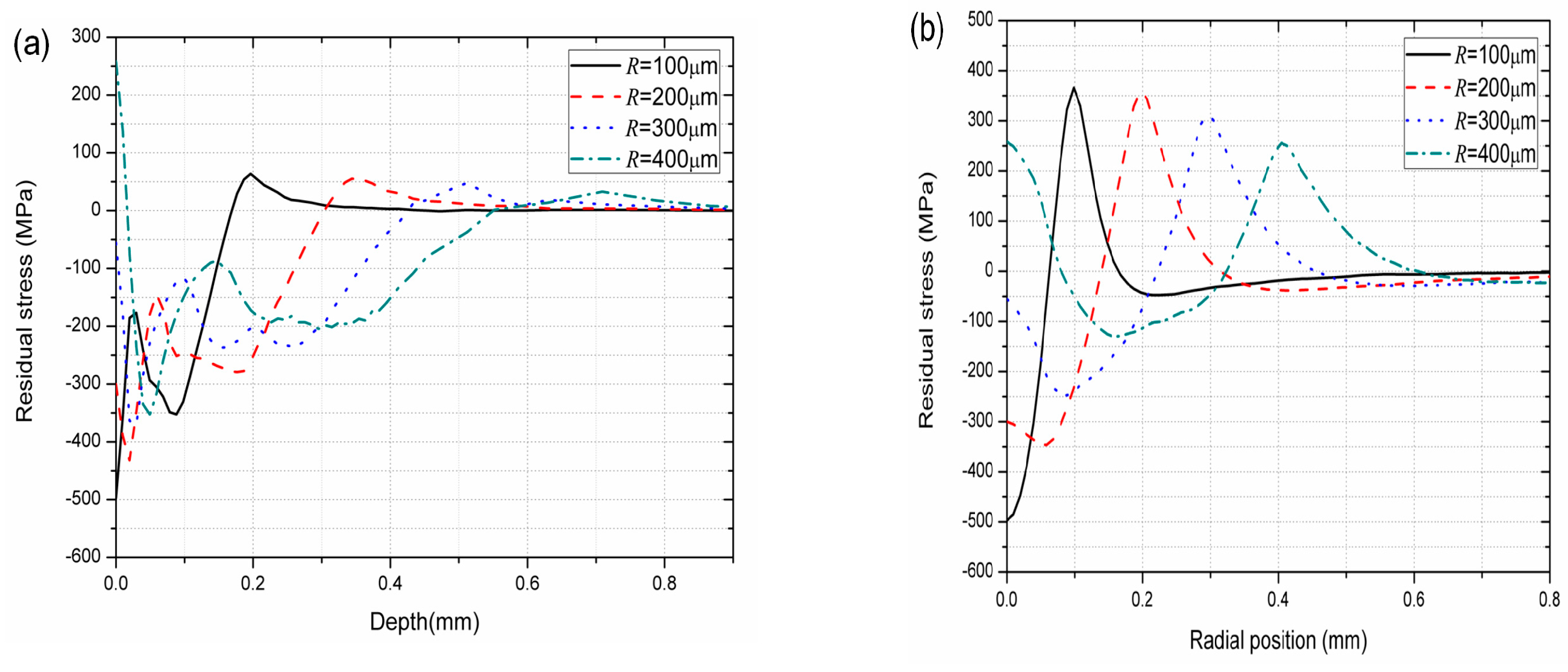
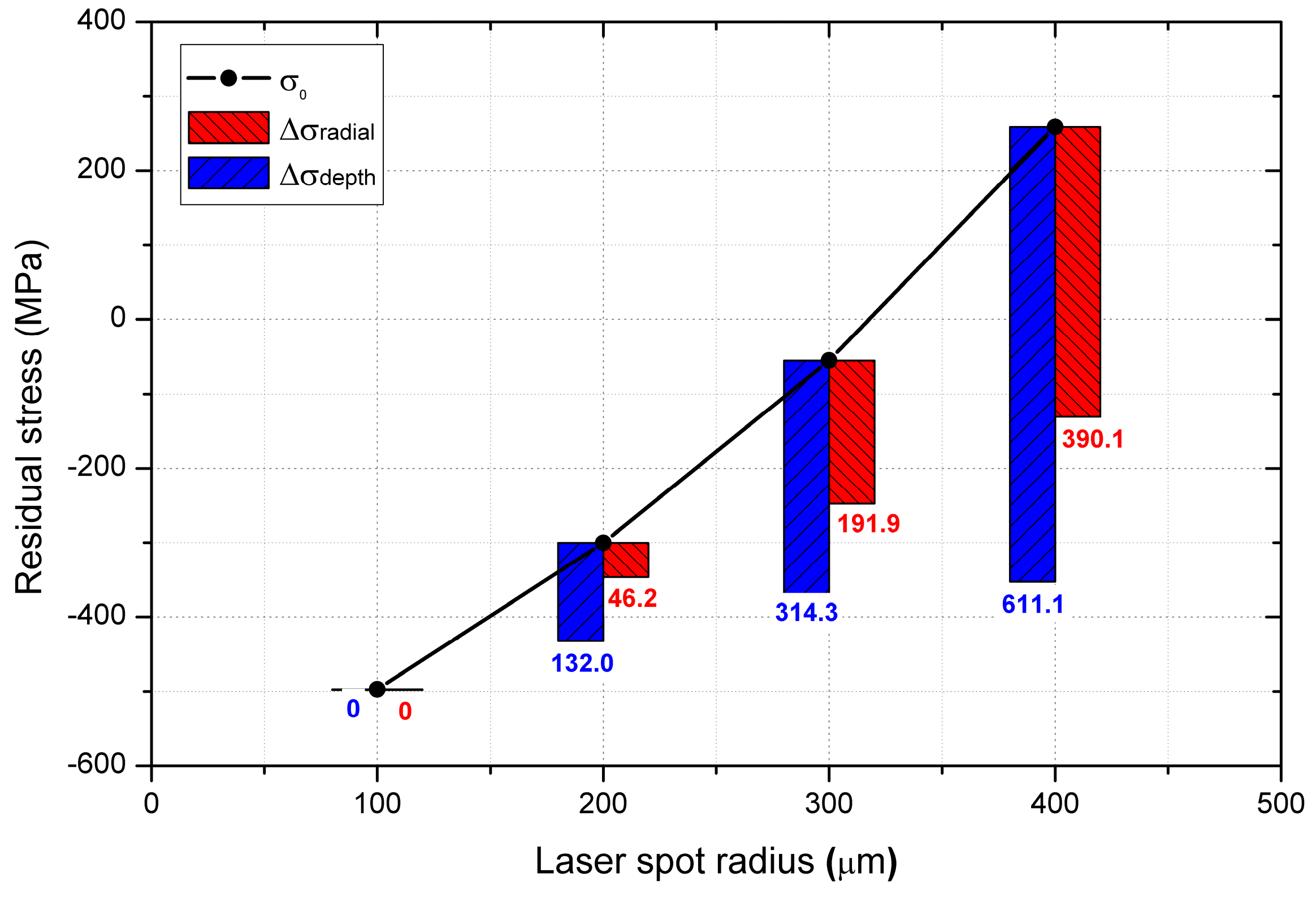
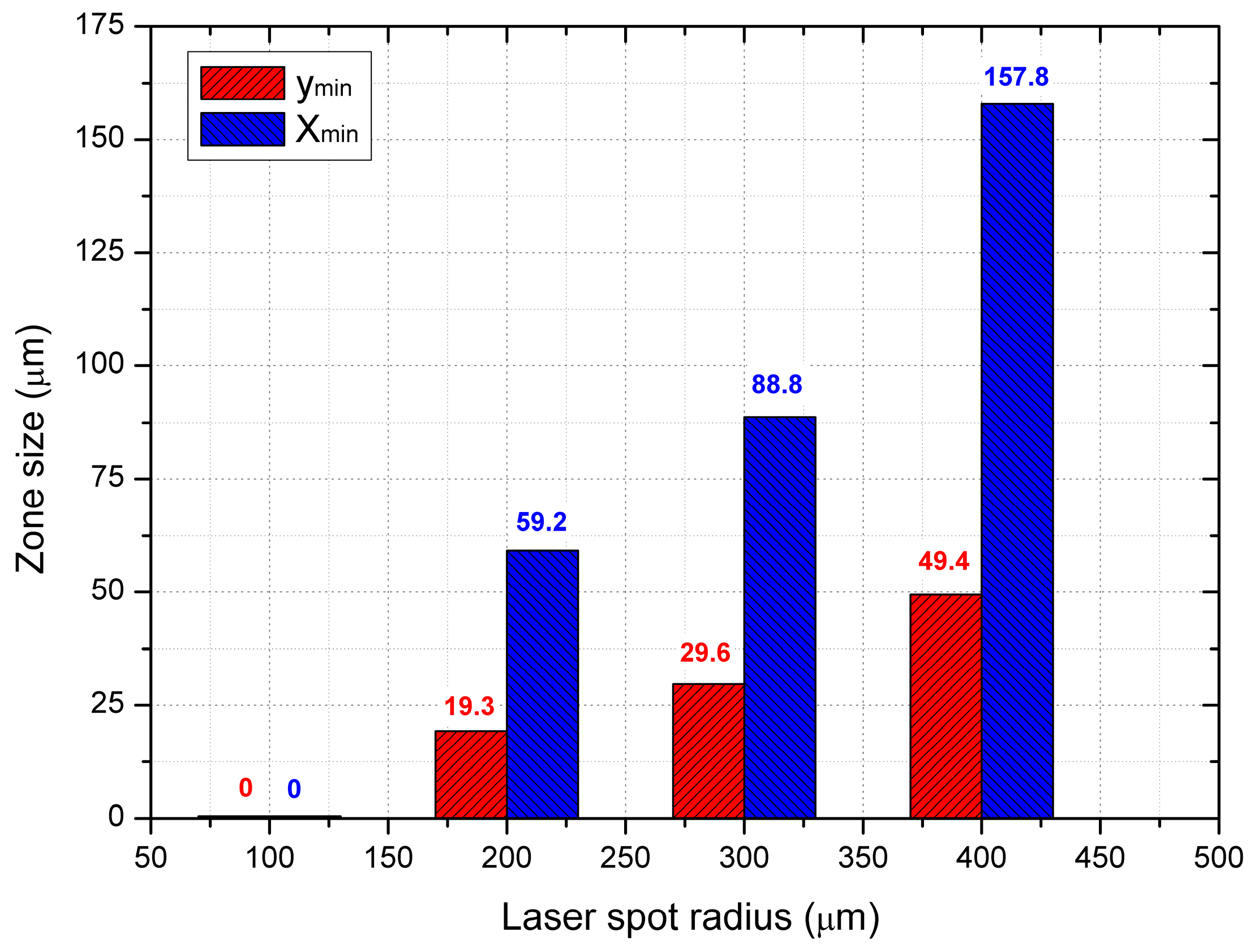
| Case Number | Mesh Size (μm) | Dimple Depth (μm) | Calculation Time(s) | |||
|---|---|---|---|---|---|---|
| Domain One | Domain Two | Domain Three | Domain Four | |||
| 1 | 25 | 50 | 100 | 200 | 22.23 | 56 |
| 2 | 20 | 40 | 80 | 160 | 22.15 | 98 |
| 3 | 15 | 30 | 60 | 120 | 21.98 | 153 |
| 4 | 10 | 20 | 40 | 80 | 21.85 | 314 |
| 5 | 8 | 16 | 32 | 64 | 21.849 | 587 |
| 6 | 5 | 10 | 20 | 40 | 21.847 | 1072 |
| Young’s Modulus E (MPa) | Poison’s Ratio μ | Density ρ (T/mm3) | Parameters Used in Johnson-Cook Model | |||
|---|---|---|---|---|---|---|
| A (MPa) | B (MPa) | n | C | |||
| 210300 | 0.30 | 7.98 × 10−9 | 305 | 441 | 0.10 | 0.057 |
| Parameters | Values |
|---|---|
| Laser wavelength, λ (nm) | 1064 |
| FWHM, τ (ns) | 20 |
| Laser frequency, f (Hz) | 4 |
| Laser power density, I0(GW/cm2) | 2.21, 4.97, 8.83, 13.80 |
| Laser spot radius, R (μm) | 100, 200, 300, 400 |
© 2019 by the authors. Licensee MDPI, Basel, Switzerland. This article is an open access article distributed under the terms and conditions of the Creative Commons Attribution (CC BY) license (http://creativecommons.org/licenses/by/4.0/).
Share and Cite
Li, K.; Wang, Y.; Cai, Y.; Hu, J. Investigation on Residual Stress Loss during Laser Peen Texturing of 316L Stainless Steel. Appl. Sci. 2019, 9, 3511. https://doi.org/10.3390/app9173511
Li K, Wang Y, Cai Y, Hu J. Investigation on Residual Stress Loss during Laser Peen Texturing of 316L Stainless Steel. Applied Sciences. 2019; 9(17):3511. https://doi.org/10.3390/app9173511
Chicago/Turabian StyleLi, Kangmei, Yifei Wang, Yu Cai, and Jun Hu. 2019. "Investigation on Residual Stress Loss during Laser Peen Texturing of 316L Stainless Steel" Applied Sciences 9, no. 17: 3511. https://doi.org/10.3390/app9173511




